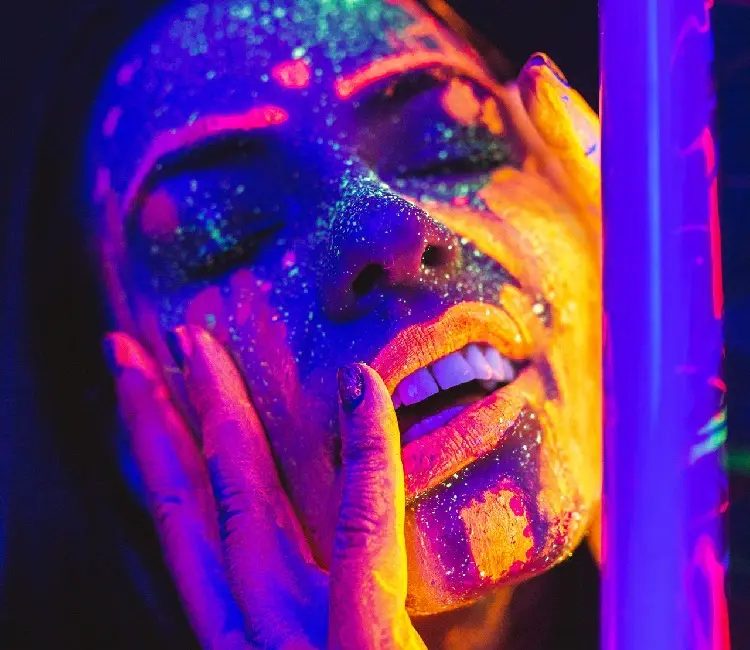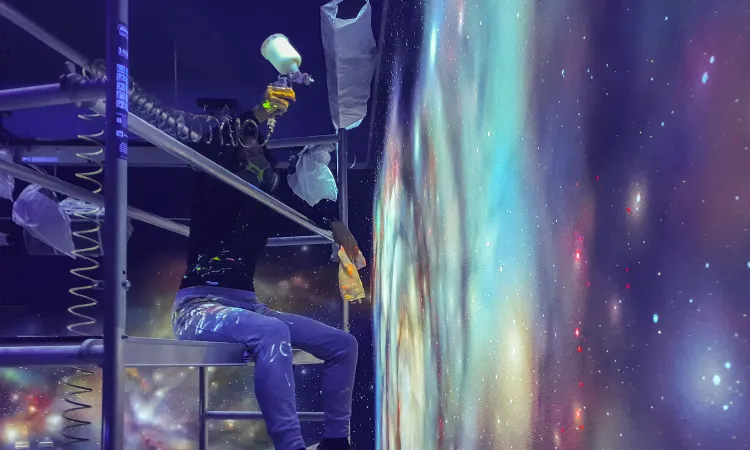Luminous or glow-in-the-dark paint is indeed intriguing. Things that glow catch attention, so using this type of paint can add more aesthetic value.
First, however, you might be wondering what it is, what chemicals it features, how it works, how to use it, and what risks it involves.
Glow in the dark paint features phosphorescent material mixed with other chemicals. The phosphor material in the paint charges when exposed to light and emits a soft glow.
Simply put, it absorbs light energy, and when it does, it releases it slowly. It works like a rechargeable battery; it stores energy and gradually releases it.
Three known pigments produce a glowing effect. The first is fluorescent, which appears to glow in broad sunlight, but not in the dark.
The second is flour-luminescent, a hybrid pigment that can glow in the dark for long hours.
Lastly, phosphorescent, which charges when exposed to UV light or artificial light – is the article’s focus.

What is Glow in the Dark Paint?
Glow in the dark paint uses special materials and chemicals.
These can include phosphorescent materials mixed with plastic and other chemical agents. I will not go very technical, but I will mention that molecular reaction happens when the paint glows.
Phosphorescent glow in the dark paints on store shelves are generally safe and non-toxic.
They are usually water-based, so they do not produce many harmful toxic fumes that could potentially cause serious health issues.
But, of course, inhaling the fumes is discouraged as it may trigger conditions like breathing difficulties and irritations.
The glowing of the paint is not similar to how a light bulb glows. Instead, science calls it luminescence, which involves luminescent materials like phosphors.
Mixing luminescent phosphors with other chemicals like radium, tritium, and promethium creates a glow.
The “glow in the dark” concept is not new. There are works of literature that support that the idea started around 1000 BC in China (this was before the discovery of phosphorous).
But when Vincenzo Casciarolo discovered phosphorous in 1602, the evolution of glow-in-the-dark objects skyrocketed.
Various glowing products flooded the market, including glow sticks and glow-in-the-dark watches.
Then, in 1908, Sabin Arnold von Sochocky invented the first luminous paint using radium as the main chemical. But unfortunately, this chemical is dangerous because it is radioactive and poisonous.
With the evolution of technology, paint manufacturers now produce various colors of glow-in-the-dark paint other than the traditional blue, green, and yellow.
This innovation became possible because of the artificial coloring that does not affect quality and brightness.
Chemicals Used in Glow in the Dark Paint
As discussed above, glow in the dark paint includes luminescent phosphors. These include silver-activated zinc sulfide or doped strontium aluminate, and calcium sulfide.
With the help of other chemicals like europium, radium, tritium, and promethium, these phosphorescent materials create a glow.
Let’s talk about them in detail below.
Phosphorescents
Phosphorescents absorb light energy and reemit it to a larger wavelength.
However, unlike the mechanisms in fluorescence, these materials do not reemit the radiation it absorbs instantly. Instead, they store up the energy first and release it gradually.
The brightness of the glow that phosphorescents emit depends on how long they charge. Of course, their natural behavior matters.
Check the common luminous compounds you will find in glow in the dark paints below.
Strontium Aluminate
Strontium aluminate is a pale yellow, odorless, non-flammable powder that is good at emitting light energy.
It has longer persistence than other phosphorescent materials. As a result, it is ten times brighter and longer glowing than zinc sulfide.
This earth material requires other chemicals like europium to produce a long-lasting glow. It is non-toxic.
However, it would be best to observe proper precautions because paint solutions contain multiple chemicals during the application process.
Zinc Sulfide
Zinc sulfide is an inorganic pigment used to produce glow-in-the-dark products like paints.
It is a pure white compound; however, it may appear black due to various impurities.
This mineral can create a strong phosphorescence when doped with suitable activators.
However, paint manufacturers minimally use zinc sulfide because of its strong odor.
Not all people can tolerate strong-odor products like paint. I, for one, hate the smell of paint chemicals because it makes me feel dizzy.
Calcium Sulfide
Calcium sulfide is another pigment that helps in the production of glow-in-the-dark paint.
This compound usually produces a red glow, but the color can change when doped with other chemicals like copper chloride.
Depending on the particle size, it can glow brighter and longer.
Paint manufacturers prefer to use strontium aluminate and zinc sulfide over this pigment.
Europium
Europium is a rare earth material that paint manufacturers use to dope phosphor materials to produce a glow.
It is an affordable soft silvery material. Aside from using this in glow in the dark paint, companies also use it on television tubes and street lamps.
There is an abundant supply of this earth material. World production is estimated to be around 100 tons annually. The mining facilities are mostly in China and the US.
This material has no known health danger but could still potentially cause health problems when ingested.
Dysprosium
Dysprosium is another chemical element in the lanthanide series with a metallic silver luster.
It was first identified in 1886 by Paul Émile Lecoq de Boisbaudran. This earth element absorbs neutrons at a high level. It is also highly magnetic susceptible.
In the later years, paint companies used this element to dope phosphor materials and produce glow in the dark paint.
This chemical is only toxic when ingested. According to ScienceDirect, ingestion of 500g or more is fatal.
Silver
Who has not heard about silver? We might be seeing it in all corners of the hours. We even wear it. But what exactly is it?
Silver is another chemical element that features high electrical and thermal conductivity and reflectivity.
No paint manufacturers use it to activate other chemicals like zinc sulfate to produce glow-in-the-dark paint.
Silver has a very low level of toxicity unless humans ingest or inhale an excessive amount. It is generally considered safe.
These chemicals you are about to learn below have been widely used in the past to create glow in the dark paints.
They are toxic and radioactive, so they are not an ideal ingredient.
Radium
Radium is an intensely radioactive silvery chemical that readily oxidizes when exposed to open air.
In the 19th century, companies used this luminescent as an additive in various products like toothpaste, hair creams, and others. In paints, it is added in the form of radium bromide to facilitate a glowing effect.
Tritium
Tritium is radioactive hydrogen that does not directly emit light. It excites phosphorescent materials to produce a glowing effect.
This chemical does not have a hazardous toxic impact because it emits ionizing radiation.
You can learn more about how this gas works in this article.
Promethium
Promethium is a rare chemical element, and all of its isotopes are radioactive. Chemically, it is considered lanthanide. Along with tritium, this chemical replaced radium-226 in most of the products.
Although its use is mainly for research, it can also act as a beta radiation source in luminous paint.
Is Glow in the Dark Paint Toxic?

Generally, glow-in-the-dark paints nowadays are non-toxic.
The reason is that the main component that paint manufacturers use, zinc sulfide or strontium aluminate, is considered safe earth material.
But let me provide you with more details about the toxicity of these compounds.
The US Food and Drug Administration (FDA) has approved the controlled use of zinc sulfide.
Although the agency labels this material as non-toxic, it suggests that its contact with human skin should be limited. There is a risk that the body will absorb it, which may cause possible issues.
Strontium aluminate is also non-radioactive and non-toxic. However, I should say, this material may still have some negative health effects.
It is evident in the usage warnings that come with the product. However, it may not be that serious.
As far as the phosphorescent materials in the paint are concerned, glow in the dark paints are non-toxic. However, I highly suggest that you check the paint’s overall composition.
You must examine the paint’s additives and solvents as they may still be dangerous.
You must note that there are also oil-based glow-in-the-dark paints on the market. If you don’t yet, these paints contain many VOCs that are harmful to human health and the environment.
It would be best to choose paints that produce less toxic fumes.
How Does Glow in the Dark Paint Work?
I still remember how I enjoyed the glowing stars on the ceiling when I was a kid. If you experienced it too, you probably also wondered how it works.
So, let’s look at how the glow in the dark paint works by understanding what happens when the paint’s chemicals are exposed.
I already discussed that phosphorescents are the key ingredients that allow the paint to glow. Of course, other components activate them to make the glow stronger and more persistent.
The information you will read below may sound a bit technical. But it should help you understand the glowing mechanism.
Electrons stay higher when the luminescent phosphor material absorbs natural or artificial energy. They find a stable state to obtain higher power, remaining in that state for a while.
Then, when they return to the ground state, the energy they absorb is radiated. This stage is when the glow happens.
In simple terms, the phosphor material in the paint is temporarily storing light energy. For the glow to occur, the luminescent phosphor needs some charging.
Sunlight energy is a good charging source for these types of paints. The glowing phenomenon may last for several hours until the light energy drains.
The luminescent phosphor particles stay in the thin layer of the paint sealed onto the wall.
They require 3 to 4 hours of exposure to sunlight energy to charge. If the pigment layer is too thick, they may not be able to charge to glow properly.
How Long Does Glow in the Dark Paint Last?
If we talk about how long the paint’s glow lasts, the answer is – it depends.
Factors influencing the duration of luminescence, including the phosphor material, the doping chemical, and the amount of energy exposure or the charging duration.
Conservatively, the paint could glow for 3 to 4 hours or more with enough charging.
Now, in terms of how long glow-in-the-dark paint retains the ability to glow, they may continue to be capable throughout their life.
Figuratively, they can emit lights for up to 10 years. However, it is also subject to the paint’s level of exposure to changing weather elements.
Can You Charge It?
As I discussed earlier, you need to charge glow in the dark paint for it to fluoresce. Of course, we are talking about natural charging.
These paints power up when exposed to light energy sources such as led lights, high wattage bulbs, UV backlight, and direct sunlight.
The best among these natural chargers are the UV backlight and natural sunlight. The paint usually glows brighter and longer when it charges from these sources.
Light bulbs can also act as paint chargers for the paint’s luminous material, but the stored energy may drain faster.
How to Use Glow in the Dark Paint?

Epic fails happen when you use a product without knowing the proper procedure.
So, if you plan to purchase glow-in-the-dark paint for your project, understand the important things to consider.
Otherwise, you could become one who complains that the product doesn’t work. Enjoy the steps below:
Step1: Stir the paint well.
There is a good reason to stir the paint before applying it to the surface. Paint solutions contain different ingredients, and you need to disperse them evenly for better results.
Glow-in-the-dark paint contains earth metals that cause the glow. These dense materials require a good stir. In stirring the paint, you must not use your hand or finger.
It can be difficult to remove if it penetrates the skin. Failure to properly mix the paint will result in an uneven glow. Some parts may glow brightly, but some may appear to be dim. Therefore, this process is a must.
Related Read: Paint Stirring vs. Paint Shaking: When and How to do?
Step 2: Apply white primer.
As these paints glow better on light surfaces, applying a white primer helps increase the intensity of the glow.
Apart from this benefit, using primers also stabilizes the surface. Furthermore, it helps hide surface dents. If you are unsure what primers are or want to understand them better, click here.
Step 3: Spread the paint thin.
You must put less paint on your brush and spread it thinly over the surface. Doing this results in the proper distribution of the glowing pigments.
When you apply the luminous materials in the paint evenly, you can achieve a more balanced and brighter glow.
Step 4: Stir again.
During the application process, you must stir the paint solution again.
Again, you must understand that the pigments that facilitate the glowing in the paint are denser than the other components.
Thus, stirring the paint solution again now and then helps.
Step 5: Apply in multiple coats.
Do not apply all the paint in the can in one go. Instead, use multiple coats on the surface to ensure a better glow.
It would be best to let the previous coat dry completely first before applying another; three layers or more result in a better fluorescence.
Step 6: Charge the paint.
Charging the paint with ultraviolet flashlights, black lights, or sunlight maximizes the paint’s glow.
High-wattage home light bulbs also charge the particles in the paint, but they usually do not produce a lasting glow.
Can You Seal Glow in the Dark Paint?
These types of paint may not withstand harsh weather conditions. So, if you use glow in the dark paint outdoors, applying a clear coat is ideal.
However, the clear sealer mustn’t be very thick. Otherwise, it may affect the charging capability of the paint. Click here to know more about the application of a paint sealant.
How to Remove Glow in the Dark Paint?
Removal of glow in the dark paint can be challenging because of the metallic pigments it contains.
The removal process varies depending on the painted surface. Below are some tips you can apply.
Removing from Walls and Ceilings
Fine-grit sandpaper is the best way to remove glow-in-the-dark paint on walls and ceilings.
If paint particles are left on the surface, you can cover them with a couple of coats of primer.
Apply the new paint when you are confident that the previous paint’s residue is fully covered.
Removing from Concrete
A metal scraper is a great help in removing the paint on a concrete surface. You can use it to scrape off most of the paint.
Of course, you cannot scrape everything away. You can remove the paint that stays on the surface after scraping using a paint thinner.
Use rags wet with paint thinner and lay them over the painted surface for at least 6 hours. When the paint becomes soft, scrape it away.
Brush the surface with a trisodium phosphate mixture and rinse it well with water to finish the removal process.
Removing from Break and Masonry Walls
Apply a masonry paint stripper to the surface and let it sit for some time. Scrape the paint away after the time you set (according to the manufacturer’s guidelines).
Then, you can wash the wall with plain water to complete the process.
Removing from Metal
The key tool to use here is a metal brush. Brush the surface repeatedly until the paint peels.
You can also sandblast the paint on the metal surface. After this, apply a rust-inhibiting primer to protect the metal.
Where to Buy Glow in the Dark Paint?
Paint stores and hardware stores sell glow-in-the-dark paint. Art paint stores also display this paint.
Stores like Walmart may have this on their shelves as well. However, online stores are the most convenient way to shop.
Various online stores sell glow-in-the-dark paint, like DecoArt, Ace Hardware, eBay, and Amazon.
I will feature five of the best products on Amazon in the following section.
5 Best Glow in the Dark Paint Paints You Can Buy on Amazon
Below are the top 5 products you can find on Amazon.
The criteria that I use in deciding which product to feature here include rating, user reviews, safety, ease of use, compatibility, glow persistency, drying time, and ease of cleaning.
StarMakerFX Glow in the Dark UV Black Light Paint
This paint charges well using black lights and UV rays. It features the latest strontium aluminate pigment.
As a result, its smell is not as strong as zinc sulfide-based paints.
You can use this paint on various projects and surfaces, including ceilings, nail art, automotive, bikes, surfboards, etc.
Users of this paint report that it glows very well; a single coat already provides a satisfying result. However, they highly recommend doing multiple coats (2 to 3 coats) for the best result.
Multiple coating ensures that the pigments are well distributed.
If some are happy with this product, a few people also pointed out some cons of using this product. The issues they encounter involve flaking, long charging duration, and short glowing time.
Pros
- Using the latest strontium aluminate pigment
- Glows brighter than zinc sulfide-based paints
- It has a mild odor
- You can use it on various substrates
Cons
- Possible flaking
- Short glowing time
- A little pricey for the package
Techno Glow Inc Glow in the Dark Paint
This product from Techno Glow Inc boasts the bright green glow it produces. Interestingly, the paint’s glow could last up to 12 hours.
On top of this, the glowing capability could stay for more than 20 years. Now, that is quite impressive.
It is also suitable for indoor and outdoor painting jobs. This paint also uses strontium aluminate doped with europium dysprosium.
It is non-toxic and environmentally friendly. However, you must avoid skin contact. Another great feature of the paint is the ease of cleaning.
Users complain that it takes multiple coats on darker surfaces. They probably did not read the description very well
. It is best to use a white primer for the best glowing result. Some users also think that the package is a little small for the price.
Pros
- Superior glowing
- Glows for up to 12 hours
- Strontium aluminate-based
- Easy to clean
Cons
- Requires white primer
- A little expensive
Blikable Ukrainian Glow in the Dark Acrylic Paint
This product is a vibrant and bright acrylic glow-in-the-dark paint manufactured in Ukraine.
The paint can glow for several hours after a good charge. There are nine available colors of this blacklight paint. This paint is ideal for party decorations.
This paint is also non-toxic and is suitable for use by kids. Kids can use this to decorate their toys, walls, and other stuff.
You can also use this paint for your outdoor projects. A paint user is happy that the paint requires minimal charging time (15 minutes) to produce a glow.
Other users report that the paint jars are a little small. Also, the paint appears to be very thin. Some of the colors may seem a little dull.
Pros
- Produces high-quality, vibrant colors
- Requires minimal charging time
- Non-toxic and suitable for use by kids
- Ideal for party decorations
Cons
- It comes in a small container
- Some colors can be dull
DecoArt DS50-10 Glow in the Dark Paint
This non-toxic acrylic glow-in-the-dark paint comes in a 4 oz plastic bottle. This paint is suitable for various substrates, including fabric, wood, plastic, paper, Styrofoam, candles, walls, ceramics, etc.
You can also use this paint for arts and crafts projects.
Its core advantage is producing a good glow even on a single coat. Users are happy about how quickly the paint dries up after application.
As far as the duration of the glow, some users report that it glows for a long period while others say only for a little while. I guess the result depends on how the user applies the paint.
The paint is a bit watery, and some users are not impressed with this characteristic.
Other users are satisfied with the paint’s performance but are unhappy with the price. They think that it is a bit expensive for what they get.
Pros
- You can use it on various surfaces/substrates
- Ideal for crafts
- Acrylic or water-based
Cons
- Pricey
- Watery solution
Individual Glow in the Dark Paint Reflective Acrylic Paint
This paint comes in a set of 8 20 ml bottles. You can easily see the color in daylight. This behavior makes the application easy. When it dries up, it produces a high-quality glow in the dark.
You must charge the paint under direct sunlight for the best glowing result. It comes in various colors, including red, orange, yellow, green, blue, purple, pink, and white pigments. This paint is ideal for making arts and crafts.
Users of the paint discover that the paint only glows best with a white primer background.
Well, most glow-in-the-dark paints behave the same. Moreover, reviews also show that the product is easy to clean.
Pros
- Good price for a set of 8
- Visibility in daylight
- Multiple color options
- Easy to clean
Cons
- It doesn’t glow well without a white primer
Precautions to Follow When Using Glow-in-the-Dark Paint
Although glow-in-the-dark paint no longer contains radioactive materials like radium, you still need to observe some precautions to ensure safety.
Even if the product is “non-toxic,” it does not mean you can use them without restrictions.
You must not allow the paint solution to get into your eyes or skin when possible. Your skin may not be able to tolerate the chemicals in the paint if it stays for longer periods.
Glow in the dark paint solution may still cause minor irritations or allergies.
If you are using it on your body for a purpose, you must ensure to remove it after an hour or two. So, if you go to a party with face paint, remove it as soon as the event is over.
Wash your face thoroughly. You probably heard about glow in the dark makeups causing irritations. The same mechanism applies to paints.
These paints are non-toxic. However, ingesting them can still be dangerous to your health. Ensure that you wear protective suits such as gloves, goggles, and masks during the application. Wearing a protective mask help prevent inhalation of the paint fumes.
When possible, paint in a well-ventilated area. Doing this helps you avoid inhaling the fumes. It enables you to breathe properly and avoid possible suffocation.
After the application, close your task by cleaning up. Change your clothes and through them in your laundry basket.
Clean up yourself. Ensure that there is no paint on your skin. If you observe irritations or allergies, seek medical assistance to get proper medication.
Verdict
Undoubtedly, glow-in-the-dark paints are getting some attention due to their aesthetic qualities.
It helps create fascinating art due to the glowing effect it produces. Most of them are now non-toxic. They likely feature strontium aluminate and zinc sulfide pigments.
When applying the glow-in-the-dark paint, it is important to stir the paint or mix it well. This step ensures a balanced glow by evenly distributing the pigments on the surface.
It is also best to apply multiple layers rather than a single coat. For the best result, a white primer can help.
Although glow-in-the-dark paints are generally non-toxic, proper precautions are still required to ensure safety.
Wear gloves and goggles to ensure that the paint does not get in contact with your skin and eyes. You must also wear a mask to prevent yourself from inhaling paint fumes.


